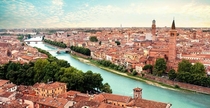
Verona
Verona (Verona or Veròna is a city on the Adige River in Veneto, Italy, with 258,108 inhabitants. It is one of the seven provincial capitals of the region. It is the second largest city municipality in the region and the third largest in northeast Italy. The metropolitan area of Verona covers an area of and has a population of 714,274 inhabitants. It is one of the main tourist destinations in northern Italy because of its artistic heritage and several annual fairs, shows, and operas, such as the lyrical season in the Arena, an ancient Roman amphitheater. Between the 13th and 14th century the city was ruled by the Della Scala Family. Under the rule of the family, in particular of Cangrande I della Scala, the city experienced great prosperity, becoming powerful, rich and being surrounded with new walls. The Della Scala era is survived in numerous monuments around Verona. Two of William Shakespeare's plays are set in Verona: Romeo and Juliet and The Two Gentlemen of Verona. It is unknown if Shakespeare ever visited Verona or Italy, but his plays have lured many visitors to Verona and surrounding cities. The city has been declared a World Heritage Site by UNESCO because of its urban structure and architecture.
See all
0
0

Tuscany
Tuscany (Toscana ) is a region in central Italy with an area of about and a population of about 3.8 million inhabitants (2013). The regional capital is Florence (Firenze). Tuscany is known for its landscapes, history, artistic legacy, and its influence on high culture. It is regarded as the birthplace of the Italian Renaissance and has been home to many figures influential in the history of art and science, and contains well-known museums such as the Uffizi and the Pitti Palace. Tuscany produces wines, including Chianti, Vino Nobile di Montepulciano, Morellino di Scansano and Brunello di Montalcino. Having a strong linguistic and cultural identity, it is sometimes considered "a nation within a nation". Tuscany is a popular destination in Italy. The main tourist spots are Florence, Pisa, Castiglione della Pescaia, Grosseto and Siena. The village of Castiglione della Pescaia is the most visited seaside destination in the region, In 2012, the city of Florence was the world's 89th most visited city, with 1.834 million arrivals.
See all
0
0
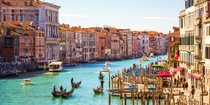
Veneto
Veneto (Vèneto ) or Venetia Article 1 defines Veneto as an "autonomous Region", "constituted by the Venetian people and the lands of the provinces of Belluno, Padua, Rovigo, Treviso, Venice, Verona and Vicenza", while maintaining "bonds with Venetians in the world". Article 2 sets forth the principle of the "self-government of the Venetian people" and mandates the Region to "promote the historical identity of the Venetian people and civilisation". Despite these affirmations, approved by the Italian Parliament, Veneto is not among the autonomous regions with special statute, differently from its north-eastern and north-western neighbours, Friuli-Venezia Giulia and Trentino-Alto Adige/Südtirol respectively. Veneto is home to a notable nationalist movement, known as Venetian nationalism or Venetism. The region's largest party is the Liga Veneta, a founding component of the Lega Nord. The current President of Veneto is Luca Zaia (Liga Veneta–Lega Nord), re-elected in 2015 with 50.1% of the vote. Zaia II Government includes also Forza Italia and is externally supported by Independence We Veneto and the Brothers of Italy. An autonomy referendum took place in 2017: 57.2% of Venetians turned out, 98.1% voting "yes" to "further forms and special conditions of autonomy". Having been for a long period in history a land of mass emigration, Veneto is today one of the greatest immigrant-receiving regions in the country, with 487,493 foreigners (9.9% of the regional population; January 2018), notably including Romanians (25.2%), Moroccans (9.3%), Chinese (7.1%), Moldovans (7.0%) and Albanians (6.9%).
See all
0
0
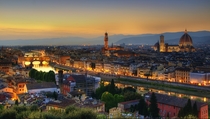
Florence
Florence (Firenze ) is a city in central Italy and the capital city of the Tuscany region. It is the most populated city in Tuscany, with 383,084 inhabitants in 2013, and over 1,520,000 in its metropolitan area. Florence was a centre of medieval European trade and finance and one of the wealthiest cities of that era. It is considered by many academics the birthplace of the Renaissance, and has been called "the Athens of the Middle Ages". Its turbulent political history includes periods of rule by the powerful Medici family and numerous religious and republican revolutions. From 1865 to 1871 the city served as the capital of the Kingdom of Italy (established in 1861). The Florentine dialect forms the base of Standard Italian and it became the language of culture throughout Italy due to the prestige of the masterpieces by Dante Alighieri, Petrarch, Giovanni Boccaccio, Niccolò Machiavelli and Francesco Guicciardini. The city attracts millions of tourists each year, and UNESCO declared the Historic Centre of Florence a World Heritage Site in 1982. The city is noted for its culture, Renaissance art and architecture and monuments. Due to Florence's artistic and architectural heritage, Forbes has ranked it as one of the most beautiful cities in the world. Florence plays an important role in Italian fashion, furthermore, it is a major national economic centre,
See all
0
0

Rome
Rome (Latin and Roma ) is the capital city and a special comune of Italy (named Comune di Roma Capitale). Rome also serves as the capital of the Lazio region. With 2,872,800 residents in is an independent country inside the city boundaries of Rome, the only existing example of a country within a city: for this reason Rome has been often defined as capital of two states. Rome's history spans 28 centuries. While Roman mythology dates the founding of Rome at around 753 BC, the site has been inhabited for much longer, making it one of the oldest continuously occupied cities in Europe. The city's early population originated from a mix of Latins, Etruscans, and Sabines. Eventually, the city successively became the capital of the Roman Kingdom, the Roman Republic and the Roman Empire, and is regarded by many as the first ever Imperial City and metropolis. It was first called The Eternal City (Urbs Aeterna; La Città Eterna) by the Roman poet Tibullus in the 1st century BC, and the expression was also taken up by Ovid, Virgil, and Livy. Rome is also called "Caput Mundi" (Capital of the World). After the fall of the Empire in the west, which marked the beginning of the Middle Ages, Rome slowly fell under the political control of the Papacy, and in the 8th century it became the capital of the Papal States, which lasted until 1870. Beginning with the Renaissance, almost all popes since Nicholas V (1447–1455) pursued a coherent architectural and urban programme over four hundred years, aimed at making the city the artistic and cultural centre of the world. In this way, Rome became first one of the major centres of the Italian Renaissance, and then the birthplace of both the Baroque style and Neoclassicism. Famous artists, painters, sculptors and architects made Rome the centre of their activity, creating masterpieces throughout the city. In 1871, Rome became the capital of the Kingdom of Italy, which, in 1946, became the Italian Republic. As of 2019, Rome is ranked as an Alpha- global city by the Globalization and World Cities Research Network. Its historic centre is listed by UNESCO as a World Heritage Site. Host city for the 1960 Summer Olympics, Rome is also the seat of several specialized agencies of the United Nations, such as the Food and Agriculture Organization (FAO), the World Food Programme (WFP) and the International Fund for Agricultural Development (IFAD). The city also hosts the Secretariat of the Parliamentary Assembly of the Union for the Mediterranean (UfM) as well as the headquarters of many international business companies such as Eni, Enel, TIM, Leonardo S.p.A., and national and international banks such as Unicredit and BNL. Rome's EUR business district is the home of many companies involved in the oil industry, the pharmaceutical industry, and financial services. The presence of renowned international brands in the city have made Rome an important centre of fashion and design, and the Cinecittà Studios have been the set of many Academy Award–winning movies.
See all
0
0
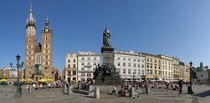
Kraków
Kraków (also ), written in English as Krakow and traditionally known as Cracow, is the second largest and one of the oldest cities in Poland. Situated on the Vistula River in Lesser Poland Province, the city dates back to the 7th century. and has traditionally been one of the leading centres of Polish academic, economic, cultural and artistic life. Cited as one of Europe's most beautiful cities, its Old Town was declared the first UNESCO World Heritage Site in the world. The city has grown from a Stone Age settlement to Poland's second most important city. It began as a hamlet on Wawel Hill and was already being reported as a busy trading centre of Central Europe in 965. However, the city was spared from destruction and major bombing. In 1978, Karol Wojtyła, archbishop of Kraków, was elevated to the papacy as Pope John Paul II—the first non-Italian pope in 455 years. Its extensive cultural heritage across the epochs of Gothic, Renaissance and Baroque architecture includes the Wawel Cathedral and the Royal Castle on the banks of the Vistula, the St. Mary's Basilica, Saints Peter and Paul Church and the largest medieval market square in Europe, the Rynek Główny. Kraków is home to Jagiellonian University, one of the oldest universities in the world and traditionally Poland's most reputable institution of higher learning. In 2000, Kraków was named European Capital of Culture. In 2013, Kraków was officially approved as a UNESCO City of Literature. The city hosted the World Youth Day in July 2016.
See all
0
0

Odessa
Odessa or Odesa (Оде́са Оде́сса ) is the third most populous city of Ukraine and a major tourism center, seaport and transport hub located on the northwestern shore of the Black Sea. It is also the administrative center of the Odessa Oblast and a multiethnic cultural center. Odessa is sometimes called the "pearl of the Black Sea", the "South Capital" (under the Russian Empire and Soviet Union), and "Southern Palmyra". Before the Tsarist establishment of Odessa, an ancient Greek settlement existed at its location. A more recent Tatar settlement was also founded at the location by Hacı I Giray, the Khan of Crimea in 1440 that was named after him as "Hacıbey". After a period of Lithuanian Grand Duchy control, Hacibey and surroundings became part of the domain of the Ottomans in 1529 and remained there until the empire's defeat in the Russo-Turkish War of 1792. In 1794, the city of Odessa was founded by a decree of the Russian empress Catherine the Great. From 1819 to 1858, Odessa was a free port—a porto-franco. During the Soviet period, it was the most important port of trade in the Soviet Union and a Soviet naval base. On 1 January 2000, the Quarantine Pier at Odessa Commercial Sea Port was declared a free port and free economic zone for a period of 25 years. During the 19th century, Odessa was the fourth largest city of Imperial Russia, after Moscow, Saint Petersburg and Warsaw. Its historical architecture has a style more Mediterranean than Russian, having been heavily influenced by French and Italian styles. Some buildings are built in a mixture of different styles, including Art Nouveau, Renaissance and Classicist. Odessa is a warm-water port. The city of Odessa hosts both the Port of Odessa and Port Yuzhne, a significant oil terminal situated in the city's suburbs. Another notable port, Chornomorsk, is located in the same oblast, to the south-west of Odessa. Together they represent a major transport hub integrating with railways. Odessa's oil and chemical processing facilities are connected to Russian and European networks by strategic pipelines.
See all
0
0

Kiev Oblast
Kiev Oblast or Kyiv Oblast (Київська область, translit. Kyivs’ka oblast’; also referred to as Kyivshchyna – Київщина) is an oblast (province) in central Ukraine. The administrative center of the oblast is the city of Kiev (Київ, Kyiv), which also serves as the capital of Ukraine. Despite being located in the center of the Kiev Oblast, and hosting the governing bodies of the oblast, Kiev itself is a self-governing city with special status and not under oblast jurisdiction. Kiev Oblast neither corresponds to nor is limited to the unofficially designated Kiev metropolitan area although it is significantly dependent on the urban economy and transportation of the latter. The largest city in the oblast is Bila Tserkva. The Chernobyl Exclusion Zone is technically located within the northern part of the Kiev Oblast but access to the Zone is prohibited to the public and it is administered separately from the oblast.
See all
0
0
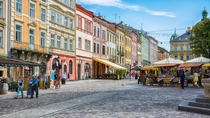
Lviv
Lviv (Львів Львігород; Lwów Львов Lemberg; Leopolis; see also other names) is the largest city in western Ukraine and the seventh-largest city in the country overall, with a population of 724,241 as of 2020. Lviv is one of the main cultural centres of Ukraine. Named in honour of Leo, the eldest son of Daniel, King of Ruthenia, it was the capital of the Kingdom of Galicia–Volhynia from 1272 to 1349, when it was conquered by King Casimir III the Great of Poland. From 1434, it was the regional capital of the Ruthenian Voivodeship in the Kingdom of Poland. In 1772, after the First Partition of Poland, the city became the capital of the Habsburg Kingdom of Galicia and Lodomeria. In 1918, for a short time, it was the capital of the West Ukrainian People's Republic. Between the wars, the city was the centre of the Lwów Voivodeship in the Second Polish Republic. After the German-Soviet invasion of Poland in 1939, Lviv became part of the Soviet Union, and in 1944–46 there was a population exchange between Poland and Soviet Ukraine. In 1991, it became part of the independent nation of Ukraine. Administratively, Lviv serves as the administrative centre of Lviv Oblast and has the status of city of oblast significance. Lviv was the centre of the historical regions of Red Ruthenia and Galicia. The historical heart of the city, with its old buildings and cobblestone streets, survived Soviet and German occupations during World War II largely unscathed. The city has many industries and institutions of higher education such as Lviv University and Lviv Polytechnic. Lviv is also the home of many cultural institutions, including a philharmonic orchestra and the Lviv Theatre of Opera and Ballet. The historic city centre is on the UNESCO World Heritage List.
See all
0
0
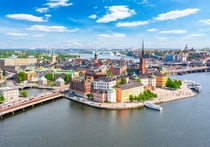
Stockholm
Stockholm is the capital and most populous urban area of Sweden. 972,647 people live in the municipality, approximately 1.6 million in the urban area, The city stretches across fourteen islands where Lake Mälaren flows into the Baltic Sea. Outside the city to the east, and along the coast, is the island chain of the Stockholm archipelago. The area has been settled since the Stone Age, in the 6th millennium BC, and was founded as a city in 1252 by Swedish statesman Birger Jarl. It is also the county seat of Stockholm County. Stockholm is the cultural, media, political, and economic centre of Sweden. The Stockholm region alone accounts for over a third of the country's GDP, and is among the top 10 regions in Europe by GDP per capita. It is an important global city, and the main centre for corporate headquarters in the Nordic region. The city is home to some of Europe's top ranking universities, such as the Stockholm School of Economics, Karolinska Institute and KTH Royal Institute of Technology. It hosts the annual Nobel Prize ceremonies and banquet at the Stockholm Concert Hall and Stockholm City Hall. One of the city's most prized museums, the Vasa Museum, is the most visited non-art museum in Scandinavia. The Stockholm metro, opened in 1950, is well known for the decor of its stations; it has been called the longest art gallery in the world. Sweden's national football arena is located north of the city centre, in Solna. Ericsson Globe, the national indoor arena, is in the southern part of the city. The city was the host of the 1912 Summer Olympics, and hosted the equestrian portion of the 1956 Summer Olympics otherwise held in Melbourne, Victoria, Australia. Stockholm is the seat of the Swedish government and most of its agencies, including the highest courts in the judiciary, and the official residencies of the Swedish monarch and the Prime Minister. The government has its seat in the Rosenbad building, the Riksdag (Swedish parliament) is seated in the Parliament House, and the Prime Minister's residence is adjacent at Sager House. Stockholm Palace is the official residence and principal workplace of the Swedish monarch, while Drottningholm Palace, a World Heritage Site on the outskirts of Stockholm, serves as the Royal Family's private residence.
See all
0
0

Helsinki
Helsinki (or Helsingfors ) is the capital and most populous city of Finland. Located on the shore of the Gulf of Finland, it is the seat of the region of Uusimaa in southern Finland, and has a population of . The city's urban area has a population of making it by far the most populous urban area in Finland as well as the country's most important center for politics, education, finance, culture, and research. Helsinki is located north of Tallinn, Estonia, east of Stockholm, Sweden, and west of Saint Petersburg, Russia. It has close historical ties with these three cities. Together with the cities of Espoo, Vantaa, and Kauniainen, and surrounding commuter towns, Helsinki forms the Greater Helsinki metropolitan area, which has a population of nearly 1.5 million. Often considered to be Finland's only metropolis, it is the world's northernmost metro area with over one million people as well as the northernmost capital of an EU member state. After Stockholm and Oslo, Helsinki is the third largest municipality in the Nordic countries. Finnish and Swedish are both official languages. The city is served by the international Helsinki Airport, located in the neighboring city of Vantaa, with frequent service to many destinations in Europe and Asia. Helsinki was the World Design Capital for 2012, the venue for the 1952 Summer Olympics, and the host of the 52nd Eurovision Song Contest in 2007. Helsinki has one of the world's highest urban standards of living. In 2011, the British magazine Monocle ranked Helsinki the world's most liveable city in its liveable cities index. In the Economist Intelligence Unit's 2016 liveability survey, Helsinki was ranked ninth among 140 cities.
See all
0
0

Vienna
Vienna (Wien ) is the national capital, largest city, and one of nine states of Austria. Vienna is Austria's most populous city, with about 1.9 million inhabitants nearly one third of the country's population), and its cultural, economic, and political centre. It is the 6th-largest city by population within city limits in the European Union. Until the beginning of the 20th century, it was the largest German-speaking city in the world, and before the splitting of the Austro-Hungarian Empire in World War I, the city had 2 million inhabitants. Today, it is the second-largest German-speaking city after Berlin. Vienna is host to many major international organizations, including the United Nations, OPEC and the OSCE. The city is located in the eastern part of Austria and is close to the borders of the Czech Republic, Slovakia and Hungary. These regions work together in a European Centrope border region. Along with nearby Bratislava, Vienna forms a metropolitan region with 3 million inhabitants. In 2001, the city centre was designated a UNESCO World Heritage Site. In July 2017 it was moved to the list of World Heritage in Danger. Additionally to being known as the "City of Music" due to its musical legacy, Vienna is also said to be the "City of Dreams", because of it being home to the world's first psychoanalyst Sigmund Freud. Vienna's ancestral roots lie in early Celtic and Roman settlements that transformed into a Medieval and Baroque city. It is well known for having played a pivotal role as a leading European music centre, from the age of Viennese Classicism through the early part of the 20th century. The historic centre of Vienna is rich in architectural ensembles, including Baroque palaces and gardens, and the late-19th-century Ringstraße lined with grand buildings, monuments and parks. Vienna is known for its high quality of life. In a 2005 study of 127 world cities, the Economist Intelligence Unit ranked the city first (in a tie with Vancouver and San Francisco) for the world's most liveable cities. Between 2011 and 2015, Vienna was ranked second, behind Melbourne. In 2018, it replaced Melbourne as the number one spot and continued as the first in 2019. For ten consecutive years (2009–2019), the human-resource-consulting firm Mercer ranked Vienna first in its annual "Quality of Living" survey of hundreds of cities around the world. Monocle's 2015 "Quality of Life Survey" ranked Vienna second on a list of the top 25 cities in the world "to make a base within." The UN-Habitat classified Vienna as the most prosperous city in the world in 2012/2013. The city was ranked 1st globally for its culture of innovation in 2007 and 2008, and sixth globally (out of 256 cities) in the 2014 Innovation Cities Index, which analyzed 162 indicators in covering three areas: culture, infrastructure, and markets. Vienna regularly hosts urban planning conferences and is often used as a case study by urban planners. Between 2005 and 2010, Vienna was the world's number-one destination for international congresses and conventions. It attracts over 6.8 million tourists a year.
See all
0
0

Istanbul
Istanbul (İstanbul ), formerly known as Byzantium and Constantinople, is the most populous city in Turkey and the country's economic, cultural and historic center. Istanbul is a transcontinental city in Eurasia, straddling the Bosporus strait (which separates Europe and Asia) between the Sea of Marmara and the Black Sea. Its commercial and historical center lies on the European side and about a third of its population lives in suburbs on the Asian side of the Bosporus. With a total population of around 15 million residents in its metropolitan area, the city grew in size and influence, becoming one of the most important cities in history. After its reestablishment as Constantinople in 330 CE, it served as an imperial capital for almost 16 centuries, during the Roman/Byzantine (330–1204), Latin (1204–1261), Palaiologos Byzantine (1261–1453) and Ottoman (1453–1922) empires. It was instrumental in the advancement of Christianity during Roman and Byzantine times, before the Ottomans conquered the city in 1453 CE and transformed it into an Islamic stronghold and the seat of the Ottoman Caliphate. Under the name Constantinople it was the Ottoman capital until 1923. The capital was then moved to Ankara and the city was renamed Istanbul. The city held the strategic position between the Black Sea and the Mediterranean. It was also on the historic Silk Road. It controlled rail networks between the Balkans and the Middle East, and was the only sea route between the Black Sea and the Mediterranean. In 1923, after the Turkish War of Independence, Ankara was chosen as the new Turkish capital, and the city's name was changed to Istanbul. Nevertheless, the city maintained its prominence in geopolitical and cultural affairs. The population of the city has increased tenfold since the 1950s, as migrants from across Anatolia have moved in and city limits have expanded to accommodate them. Arts, music, film, and cultural festivals were established towards the end of the 20th century and continue to be hosted by the city today. Infrastructure improvements have produced a complex transportation network in the city. Over foreign visitors came to Istanbul in 2015, five years after it was named a European Capital of Culture, making the city the world's fifth most popular tourist destination. The city's biggest attraction is its historic center, partially listed as a UNESCO World Heritage Site, and its cultural and entertainment hub is across the city's natural harbor, the Golden Horn, in the Beyoğlu district. Considered a global city, It hosts the headquarters of many Turkish companies and media outlets and accounts for more than a quarter of the country's gross domestic product. Hoping to capitalize on its revitalization and rapid expansion, Istanbul has bid for the Summer Olympics five times in twenty years.
See all
0
0
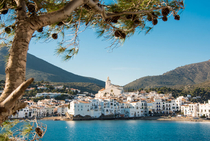
Cadaqués
Cadaqués is a town in the Alt Empordà comarca, in the province of Girona, Catalonia, Spain. It is on a bay in the middle of the Cap de Creus peninsula, near Cap de Creus cape, on the Costa Brava of the Mediterranean. It is two-and-a-quarter-hour drive from Barcelona, and thus it is accessible not only to tourists but also to people who want a second home for weekends and summers. In 2002, Cadaqués had an official population of 2,612, but up to ten times as many people can live in the town during the peak of the summer tourism season. Cadaqués has a special place in art history. Commanding charcoals, by local artist Eliseu Meifrèn, of the 19th century Cadaqués beleaguered by a winter tramontane, can be seen at the Cadaqués museum. Fren was the first modern artist to live in Cadaqués and gave the town many of his works and a marble top table on which he sketched many of its turn-of-the-century fishermen. Salvador Dalí often visited Cadaqués in his childhood, and later kept a home in Port Lligat, a small village on a bay next to the town. A summer holiday here in 1916, spent with the family of Ramon Pichot is seen as especially important to Dalí's artistic career. Other notable artists, including Pablo Picasso, Joan Miró, Marcel Duchamp, Richard Hamilton, Albert Ràfols-Casamada, Antoni Pitxot, Henri-François Rey, Melina Mercouri and Maurice Boitel also spent time here. Cadaqués is mentioned in the story "Tramontana" by Gabriel García Márquez. The interesting submarine life of this sleepy fishing village was studied for several years by phycologist Françoise Ardré, long before Cadaqués was discovered and transformed into a tourism destination. On Mondays there is a travelling market in Cadaqués, located near the parking lot. This market has a wide variety of products.
See all
0
0
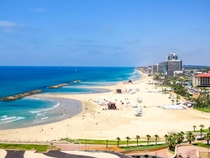
Herzliya
Herzliya is an affluent city in the central coast of Israel, at the Northern part of the Tel Aviv District known for its robust start-up and entrepreneurial culture. In it had a population of . Named after Theodor Herzl, the founder of modern Zionism, Herzliya covers an area of . At its western municipal boundaries is Herzliya Pituah, one of Israel's most affluent neighborhoods and home to numerous embassies, company headquarters, as well as prominent Israeli business people.
See all
0
0

Zikhron Ya'akov
Zikhron Ya'akov (lit. "Jacob's Memorial"; often shortened to just Zikhron) is a town in Israel, south of Haifa, and part of the Haifa District. It is located at the southern end of the Carmel mountain range overlooking the Mediterranean Sea, near the coastal highway (Highway 2). It was one of the first Jewish settlements of Halutzim in the country, founded in 1882 by Baron Edmond James de Rothschild and named in honor of his father, James Mayer de Rothschild. In it had a population of .
See all
0
0
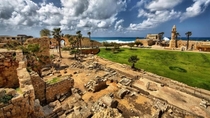
Caesarea
Caesarea (قيسارية, ), Keysariya or Qesarya, often simplified to Keisarya, and Qaysaria, is a town in north-central Israel, which inherits its name and much of its territory from the ancient city of Caesarea Maritima (Καισάρεια and also one of the most populous localities not recognized as a local council. The ancient city of Caesarea Maritima was built by Herod the Great about 25–13 BCE as a major port. It served as an administrative center of Judaea Province of the Roman Empire, and later as the capital of the Byzantine Palaestina Prima province. During the Muslim conquest in the 7th century, it was the last city of the Holy Land to fall to the Arabs. The city degraded to a small village after the provincial capital was moved from here to Ramleh and had an Arab majority until Crusader conquest. Under the Crusaders it became once again a major port and a fortified city. It was diminished after the Mamluk conquest. In 1884, Bosniak immigrants settled there establishing a small fishing village. In 1940, kibbutz Sdot Yam was established next to the Bosniak village. In February 1948, the Bosniak village was conquered by a Palmach unit commanded by Yitzhak Rabin, its people already having fled following an earlier attack by the Lehi paramilitary group. In 1952, the modern Jewish town of Caesarea was established near the ruins of the old city, which in 2011 were incorporated into the newly-created Caesarea National Park.
See all
0
0

Haifa
Haifa (' حيفا ') It is home to the Baháʼí World Centre, and is a UNESCO World Heritage Site and a destination for Baháʼí pilgrims. Built on the slopes of Mount Carmel, the settlement has a history spanning more than 3,000 years. The earliest known settlement in the vicinity was Tell Abu Hawam, a small port city established in the Late Bronze Age (14th century BCE). In the 3rd century CE, Haifa was known as a dye-making center. Over the millennia, the Haifa area has changed hands: being conquered and ruled by the Canaanites, Israelites, Phoenicians, Persians, Hasmoneans, Romans, Byzantines, Arabs, Crusaders, Ottomans, and the British. Since the establishment of the Israeli state in 1948, the Haifa Municipality has governed the city. the city is a major seaport located on Israel's Mediterranean coastline in the Bay of Haifa covering . It lies about north of Tel Aviv and is the major regional center of northern Israel. According to researcher Jonathan Kis-Lev, Haifa is considered a relative haven for coexistence between Jews and Arabs. Two respected academic institutions, the University of Haifa and the Technion, are located in Haifa, in addition to the largest K–12 school in Israel, the Hebrew Reali School. The city plays an important role in Israel's economy. It is home to Matam, one of the oldest and largest high-tech parks in the country; Haifa also owns the only underground rapid transit system located in Israel, known as the Carmelit. Haifa Bay is a center of heavy industry, petroleum refining and chemical processing. Haifa formerly functioned as the western terminus of an oil pipeline from Iraq via Jordan.
See all
0
0
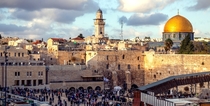
Jerusalem
Jerusalem (; القُدس ) is a city in the Middle East, located on a plateau in the Judaean Mountains between the Mediterranean and the Dead Sea. It is one of the oldest cities in the world, and is considered holy to the three major Abrahamic religions—Judaism, Christianity, and Islam. Both Israel and the Palestinian Authority claim Jerusalem as their capital, as Israel maintains its primary governmental institutions there and the State of Palestine ultimately foresees it as its seat of power; however, neither claim is widely recognized internationally. During its long history, Jerusalem has been destroyed at least twice, besieged 23 times, captured and recaptured 44 times, and attacked 52 times. The part of Jerusalem called the City of David shows first signs of settlement in the 4th millennium BCE, in the shape of encampments of nomadic shepherds. Jerusalem was named as Urusalim on ancient Egyptian tablets, probably meaning "City of Shalem" after a Canaanite deity, during the Canaanite period (14th century BCE). During the Israelite period, significant construction activity in Jerusalem began in the 9th century BCE (Iron Age II), and in the 8th century the city developed into the religious and administrative center of the Kingdom of Judah. In 1538, the city walls were rebuilt for a last time around Jerusalem under Suleiman the Magnificent. Today those walls define the Old City, which has been traditionally divided into four quarters—known since the early 19th century as the Armenian, Christian, Jewish, and Muslim Quarters. The Old City became a World Heritage Site in 1981, and is on the List of World Heritage in Danger. Since 1860 Jerusalem has grown far beyond the Old City's boundaries. In 2015, Jerusalem had a population of some 850,000 residents, comprising approximately 200,000 secular Jewish Israelis, 350,000 Haredi Jews and 300,000 Palestinians. In 2016, the population was 882,700, of which Jews comprised 536,600 (60.8%), Muslims 319,800 (36.2%), Christians 15,800 (1.8%), and 10,300 unclassified (1.2%). one of the Ancient Canaanite deities. These foundational events, straddling the dawn of the 1st millennium BCE, assumed central symbolic importance for the Jewish people. The sobriquet of holy city (עיר הקודש, transliterated 'ir haqodesh) was probably attached to Jerusalem in post-exilic times. The holiness of Jerusalem in Christianity, conserved in the Septuagint which Christians adopted as their own authority, was reinforced by the New Testament account of Jesus's crucifixion there. In Sunni Islam, Jerusalem is the third-holiest city, after Mecca and Medina. In Islamic tradition, in 610 CE it became the first qibla, the focal point for Muslim prayer (salat), and Muhammad made his Night Journey there ten years later, ascending to heaven where he speaks to God, according to the Quran. As a result, despite having an area of only the Old City is home to many sites of seminal religious importance, among them the Temple Mount with its Western Wall, Dome of the Rock and al-Aqsa Mosque, and the Church of the Holy Sepulchre. Outside the Old City stands the Garden Tomb. Today, the status of Jerusalem remains one of the core issues in the Israeli–Palestinian conflict. During the 1948 Arab–Israeli War, West Jerusalem was among the areas captured and later annexed by Israel while East Jerusalem, including the Old City, was captured and later annexed by Jordan. Israel captured East Jerusalem from Jordan during the 1967 Six-Day War and subsequently annexed it into Jerusalem, together with additional surrounding territory. One of Israel's Basic Laws, the 1980 Jerusalem Law, refers to Jerusalem as the country's undivided capital. All branches of the Israeli government are located in Jerusalem, including the Knesset (Israel's parliament), the residences of the Prime Minister (Beit Aghion) and President (Beit HaNassi), and the Supreme Court. While the international community rejected the annexation as illegal and treats East Jerusalem as Palestinian territory occupied by Israel, Israel has a stronger claim to sovereignty over West Jerusalem.
See all
0
0
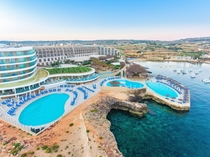
Ramla
Ramla (Ramla; الرملة, ar-Ramlah) (also Ramle, Ramlah, Remle and sometimes Rama) is a city in central Israel. The city is predominantly Jewish with a significant Arab minority. Ramla was founded circa 705–715 CE by the Umayyad governor and future caliph Sulayman ibn Abd al-Malik. Ramla lies along the route of the Via Maris, connecting old Cairo (Fustat) with Damascus, at its intersection with the road connecting the port of Jaffa with Jerusalem. It was conquered many times in the course of its history, by the Abbasids, the Ikhshidids, the Fatimids, the Seljuqs, the Crusaders, the Mameluks, the Turks, the British, and the Israelis. After an outbreak of the Black Death in 1347, which greatly reduced the population, an order of Franciscan monks established a presence in the city. Under Arab and Ottoman rule the city became an important trade center. Napoleon's French Army occupied it in 1799 on its way to Acre. The town had an Arab majority before most of its Arab inhabitants were expelled or fled during the 1948 Arab–Israeli War. The town was subsequently repopulated by Jewish immigrants. In 2001, 80% of the population were Jewish and 20% Arab (16% Arab Muslims and 4% Arab Christians). In recent years, attempts have been made to develop and beautify the city, which has been plagued by neglect, financial problems and a negative public image. New shopping malls and public parks have been built, and a municipal museum opened in 2001. A 2013 Israeli police report documented that the Central District ranks fourth among Israel's seven districts in terms of drug-related arrests. Today, five prisons are located in Ramla, including the maximum-security Ayalon Prison and Israel's only women's prison called Neve Tirza.
See all
0
0
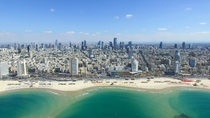
Tel Aviv
Tel Aviv-Yafo (– Tel Aviv-Yafo تَلّ أَبِيب - يَافَا – Tall ʾAbīb - Yāfā), often referred to as just Tel Aviv, is the most populous city in the Gush Dan metropolitan area of Israel. Located on the Israeli Mediterranean coastline and with a population of it is the economic and technological center of the country. If East Jerusalem is considered part of Israel, Tel Aviv is the country's second most populous city after Jerusalem; if not, Tel Aviv is the most populous city before West Jerusalem. Tel Aviv is governed by the Tel Aviv-Yafo Municipality, headed by Mayor Ron Huldai, and is home to many foreign embassies. It is a global city and is ranked 25th in the Global Financial Centres Index. Tel Aviv has the third- or fourth-largest economy and the largest economy per capita in the Middle East. The city has the 31st highest cost of living in the world. Tel Aviv receives over 2.5 million international visitors annually. A "party capital" in the Middle East, it has a lively nightlife and 24-hour culture. Tel Aviv has been called The World's Vegan Food Capital, as it possesses the highest per capita population of vegans in the world, with many vegan eateries throughout the city. Tel Aviv is home to Tel Aviv University, the largest university in the country with more than 30,000 students. The city was founded in 1909 by the Yishuv (Jewish residents) as a modern housing estate on the outskirts of the ancient port city of Jaffa, then part of the Jerusalem province of Ottoman Syria. It was at first called 'Ahuzat Bayit' (lit. "House Estate" or "Homestead"), the name of the association which established the neighbourhood, a name changed the following year to 'Tel Aviv'. Its name means "Tell of Spring", symbolising both ancient legacy and renewal. Other Jewish suburbs of Jaffa established outside Jaffa's Old City even before Tel Aviv, eventually became part of Tel Aviv, the oldest among them being Neve Tzedek (est. 1886). Immigration by mostly Jewish refugees meant that the growth of Tel Aviv soon outpaced that of Jaffa, which had a majority Arab population at the time. Tel Aviv and Jaffa were later merged into a single municipality in 1950, two years after the Israeli Declaration of Independence, which was proclaimed in the city. Tel Aviv's White City, designated a UNESCO World Heritage Site in 2003, comprises the world's largest concentration of International Style buildings, including Bauhaus and other related modernist architectural styles.
See all
0
0
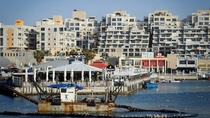
Ashkelon
Ashkelon or Ashqelon , also known as Ascalon (Askálōn; عَسْقَلَان, ''''), is a coastal city in the Southern District of Israel on the Mediterranean coast, south of Tel Aviv, and north of the border with the Gaza Strip. The ancient seaport of Ashkelon dates back to the Neolithic Age. In the course of its history, it has been ruled by the Ancient Egyptians, the Canaanites, the Philistines, the Assyrians, the Babylonians, the Greeks, the Phoenicians, the Hasmoneans, the Romans, the Persians, the Arabs and the Crusaders, until it was destroyed by the Mamluks in 1270. The Arab village of al-Majdal or al-Majdal Asqalan (المجدل; ) was established a few kilometres inland from the ancient site by the late 15th century, under Ottoman rule. In 1918, it became part of the British Occupied Enemy Territory Administration and in 1920 became part of Mandatory Palestine. Al-Majdal on the eve of the 1948 Arab–Israeli War had 10,000 Arab inhabitants and in October 1948, the city accommodated thousands more refugees from nearby villages. Al-Majdal was the forward position of the Egyptian Expeditionary Force based in Gaza. The village was conquered by Israeli forces on 5 November 1948, by which time most of the Arab population had fled, leaving some 2,700 inhabitants, of which 500 were deported by Israeli soldiers in December 1948. The town was initially named Migdal Gaza, Migdal Gad and Migdal Ashkelon by the new Jewish inhabitants. Most of the remaining Arabs were deported by 1950. In 1953, the nearby neighborhood of Afridar was incorporated and the name "Ashkelon" was readopted to the town. By 1961, Ashkelon was ranked 18th among Israeli urban centers with a population of 24,000. In the population of Ashkelon was .
See all
0
0
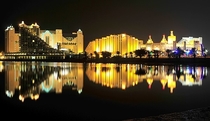
Eilat
Eilat (also ), or Umm Al-Rashrash sometimes in Arabic (أم الرشراش), is Israel's southernmost city with a population of a busy port and popular resort at the northern tip of the Red Sea, on what is known in Israel as the Gulf of Eilat and in Jordan as the Gulf of Aqaba. The city is considered a tourist destination for domestic and international tourists heading to Israel. Eilat is part of the Southern Negev Desert, at the southern end of the Arabah, adjacent to the Egyptian village of Taba to the south, the Jordanian port city of Aqaba to the east, and within sight of Haql, Saudi Arabia, across the gulf to the southeast. Eilat's arid desert climate and low humidity are moderated by proximity to a warm sea. Temperatures often exceed in summer, and in winter, while water temperatures range between . Eilat averages 360 sunny days a year.
See all
0
0
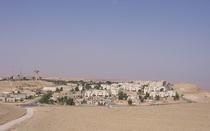
Mitzpe Ramon
Mitzpe Ramon (lit. Ramon Lookout; متسبي ريمون) is a local council in the Negev desert of southern Israel. It is situated on the northern ridge at an elevation of 860 meters (2,800 feet) overlooking the world's largest erosion cirque, known as the Makhtesh Ramon. In it had a population of .
See all
0
0
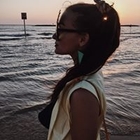
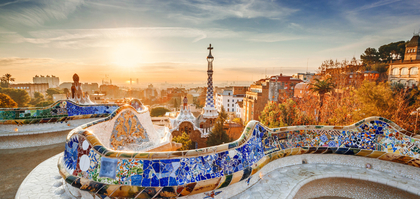





Comments